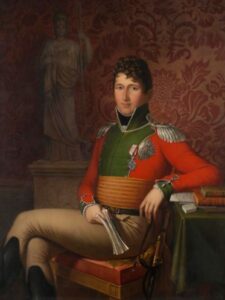 The Kingdom of Denmark-Norway had long remained neutral in the Napoleonic Wars. England, however, feared that Napoleon would attempt to conquer the Danish-Norwegian naval fleet.
The Kingdom of Denmark-Norway had long remained neutral in the Napoleonic Wars. England, however, feared that Napoleon would attempt to conquer the Danish-Norwegian naval fleet.
In a move to prevent this from happening, England attacked Copenhagen and abducted the naval fleet in September 1807. The “fleet robbery” and bombardment of Copenhagen drew Denmark-Norway into the war on the side of Napoleon.

In August 1810, Marshal of France Jean Baptiste Bernadotte was elected heir apparent to the Swedish throne. He took the name Carl Johan and rapidly assumed a leading role in Swedish foreign policy.
It was widely believed that the French marshal would support Napoleon, but instead Sweden entered the war on the side of England and Russia. Carl Johan also had his own plans: Sweden had lost Finland to Russia in 1809, and he wanted to compensate for this loss by acquiring Norway. To achieve this he would need to join the alliance against Denmark.
Agreement on Norway
Carl Johan worked hard to convince the major European powers that Denmark, upon its defeat, should be forced to cede Norway to Sweden. He gained the support of the tsar in a separate treaty, and in 1813 England also agreed not to oppose the ceding of Norway to Sweden. However, the treaty stipulated that the process should be conducted “with all possible leniency and with due regard for the happiness and freedom of the Norwegian people”.
Napoleon’s forces were greatly diminished from the catastrophic campaign against Moscow in 1812. In October 1813 Napoleon suffered yet another defeat at Leipzig. After this loss, Denmark became the target of extensive diplomatic and military pressure. The northern army, under the command of Carl Johan, occupied the Danish-German duchies of Slesvig and Holstein, and Frederik VI, fearing further advancements, agreed to Carl Johan’s demands in return for immediate withdrawal from the Danish areas and compensation in the form of Swedish holdings in Pomerania, the island of Rügen and one million rix-dollars.
King Frederik VI of Denmark ceded Norway to Sweden in the Treaty of Kiel of 14 January 1814. The Norwegian dependencies of Iceland, the Faeroe Islands and Greenland were not covered by the treaty and remained in the possession of Denmark.
Norwegian refusal
In theory Norway had gone from being a possession of the Danish king to a new subordinate role under King Carl XIII of Sweden. In practice, however, a political vacuum had arisen; while Danish authorities no longer exercised power in Norway, a Swedish presence had not yet been established.
Norway refused to accept the terms of the Kiel Treaty. The Danish king had relinquished his claim on Norway for all time. Therefore, Norway maintained that sovereignty had reverted to the Norwegian people and that the nation should be able to choose its own path.
The Convention of Moss
Carl Johan invaded Norway in July 1814 and quickly suppressed the Norwegian forces. On 14 August 1814 a peace treaty was signed in Moss, and following negotiations conducted throughout the autumn, Norway entered into a union with Sweden. However, between the signing of the Kiel Treaty in January and the establishment of the union, several significant events had taken place: Norway had managed to join the union as an independent state with its own constitution, and for a few months it had once again had its own king –Prince Christian Frederik of Denmark.
Christian Frederik was a cousin of the reigning King of Denmark, Frederik VI, and heir to the Danish throne. In 1813 he was appointed Vice-Regent in Norway. His task was to visit all parts of the country in order to strengthen the ties between Norway and Denmark and obstruct the plans of the Swedish Crown Prince, Carl Johan, who wished to make Norway part of Sweden.
Christian Frederik was smuggled from Denmark through the British blockade (Denmark-Norway had sided with France during the Napoleonic Wars). He arrived at the Norwegian islands of Hvaler on 21 May 1813, and made his way to Christiania (as Oslo was called at the time) the following day. He immediately took up his new office, and rapidly became popular among the Norwegians.
The Kiel Peace Treaty
On 17 January 1814 King Frederik informed his Vice-Regent of the terms of the Treaty of Kiel, under which Norway had been ceded to Sweden. The letter instructed Christian Frederik to surrender the Norwegian forts and return to Denmark, but Christian Frederik refused to obey. He chose instead to head the Norwegian resistance against the treaty.
Norwegian sovereignty
Christian Frederik intended to have himself made King of Norway on the basis of his position as heir to the throne. However, at a meeting of prominent Norwegians in Eidsvoll on 16 February the same year, Professor Georg Sverderup persuaded him to change his mind by arguing that with King Frederik of Denmark’s renunciation of the Norwegian throne, sovereignty had passed to the Norwegian people. Thus a Norwegian king would have to be elected by the people themselves.
Christian Frederik convened a constituent assembly, which was held at Eidsvoll on 10 April 1814.
The Constitution and the election of a king The assembly spent the period 10 April-17 May drafting a new Norwegian constitution, based on forward-looking liberal and democratic principles. The assembly also decided that Norway should continue to be a monarchy, and on 17 May Christian Frederik was unanimously elected King of Norway.
War with Sweden

Public Domain
Crown Prince Carl Johan refused to accept Norwegian independence, and appealed to the major powers for support in enforcing the Kiel Treaty. A delegation was dispatched to Norway to negotiate with Christian Frederik but it was unsuccessful. On 29 July Carl Johan’s forces marched into Norway.
Norwegian resistance was soon quelled, and Norway requested a ceasefire. On 14 August both parties signed the Convention of Moss. Christian Frederik agreed to cede power and leave the country.
King Christian Frederik abdicates
On 10 October 1814, at Bygdø Royal Farm, King Christian Frederik gave up the Norwegian throne, and on 28 October he left the country.
In 1839, Christian Fredrik became King of Denmark, where he reigned until 1848.
Content from the Royal House of Norway website